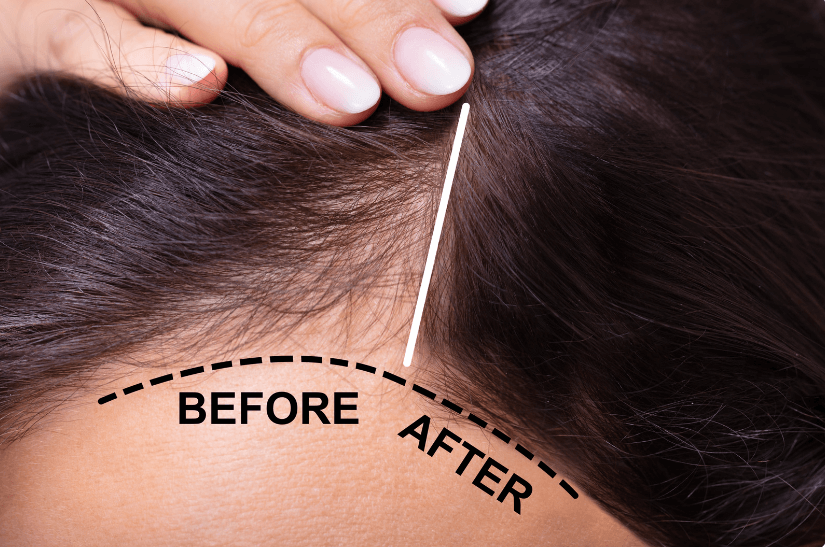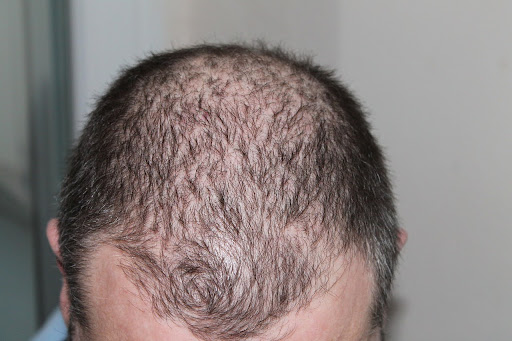Key Takeaways:
- Male pattern baldness (MPB) is a genetic condition primarily driven by sensitivity to the hormone dihydrotestosterone (DHT), causing gradual hair loss in a characteristic pattern, often beginning with a receding hairline.
- Although there is no cure for MPB, various treatments, including medications like minoxidil and finasteride, surgical options, and natural remedies, can slow its progression and promote hair regrowth, even in cases of androgenetic alopecia.
- Preventing male pattern hair loss in men is challenging, but early intervention, a healthy diet, stress management, and gentle hair care practices can help minimize hair loss and maintain hair health.
Male pattern baldness (MPB), also known as male androgenetic alopecia, is the leading cause of hair loss in men, impacting millions worldwide. MPB, which is characterized by receding hairlines and hair loss at the crown, can be disconcerting, but it is a normal aspect of aging for many men.
What Is Male Pattern Baldness?
Male pattern baldness is a genetic condition that causes gradual hair loss, usually beginning with a mature hairline and thinning hair on the crown of the head. The disorder affects around 50 million males in the United States alone, with almost 30% displaying indications of MPB by the age of 30, and roughly 50% by the age of 50.
The primary reason is a hereditary sensitivity to the hormone dihydrotestosterone (DHT) generated from testosterone. This sensitivity causes hair follicles to shrink, resulting in shorter, finer hair strands and no hair growth, eventually leading to further hair loss.
According to a research published, the conversion of testosterone to DHT in genetically sensitive hair follicles plays an important role in developing androgenetic alopecia, also known as MPB.
Men experiencing losing hair often notice changes in their entire hairline, which may recede or thin out as the condition progresses.
Who is At Risk of Male Pattern Baldness?
MPB affects men of all races; however, certain conditions could increase the risk.
Genetics: A family history of male pattern baldness considerably raises the risk of getting the illness, especially if there is a history of frontal fibrosing alopecia or a receding hairline.
Age: The risk of MPB rises with age, with around half of males displaying indications of hair loss, such as hairline receding, by the age of fifty.
Hormonal changes: Androgens, namely DHT, play an important role in MPB. Men with greater DHT levels are more prone to have hair loss, including hair breakage near the person’s hairline.
Medical conditions: Prostate enlargement, coronary heart disease, and diabetes have all been related to an increased risk of MPB.
Male Pattern Baldness Symptoms and Causes
Symptoms
The most obvious sign of MPB is a receding hairline, which is frequently accompanied by hair thinning at the crown. This pattern of hair loss usually follows a predictable trajectory.
- Receding hairline: Hair loss often begins at the temples and forms a “M” shape.
- Thinning at the crown: Hair loss extends to the crown, resulting in a bald area.
- Progressive hair loss: As time passes, the hairline recedes more and the bald patch on the crown grows, finally meeting the receding hairline and leaving a horseshoe-shaped fringe of hair around the sides and back of the head.
Causes
The primary cause of hairloss in men is a hereditary susceptibility to DHT. The University of Edinburgh conducted a study that discovered that over 200 genetic loci are linked to male pattern baldness, highlighting the condition’s complicated genetic underpinnings and hereditary factors. Other contributing elements are:
Hormonal imbalance: DHT is a strong testosterone derivative that binds to hair follicles, causing them to shrink and create thinner hair, leading to thinning spots and hairline recession. A research found that men with greater scalp DHT levels are considerably more likely to develop MPB.
Age: Men’s hair growth cycles shrink as they age, resulting in thinner, weaker hair. The aging process also influences the creation of DHT, which contributes to the advancement of male pattern baldness and the transition from a juvenile hairline to mature hairlines.
Nutritional deficiencies: A lack of vital minerals such as iron, zinc, and vitamin D can worsen hair loss. According to a recent study, micronutrients have a role in hair loss, particularly in people with hereditary factors.
Stress: Chronic stress can cause or accelerate hair loss through processes such as telogen effluvium, in which stress forces hair follicles to enter a resting phase prematurely. A research connected high stress levels to higher hair loss in males who are prone to male pattern baldness.
Male Pattern Baldness Stages
Male pattern baldness proceeds through various phases, which are commonly classified using the Norwood-Hamilton Scale, which offers a visual depiction of the degree of hair loss.
- Stage 1: Minimal or no receding hairline.
- Stage 2: A modest recession of the temples.
- Stage 3: The earliest evidence of substantial baldness, with a developing recession at the temples.
- Stage 4: Further temple recession and considerable crown thinning.
- Stage 5: The hair loss patches around the temples and head begin to blend.
- Stage 6: The bridge of hair over the top of the head is gone, leaving just a horseshoe-shaped fringe.
- Stage 7: The most advanced stage, with only a thin band of hair remaining around the sides and back of the head.
Male Pattern Baldness Treatment

While there is no cure for male pattern baldness, several treatment options can delay its progression and, in certain cases, also help hair regrow. These treatments include over-the-counter medicines, prescription medications, and surgical procedures.
Minoxidil (Rogaine)
An over-the-counter topical treatment that promotes hair growth-promoting effects while slowing hair loss. Minoxidil has been demonstrated in studies to be effective in 60-70% of men with MPB when taken consistently for four to six months.
Finasteride (Propecia)
It is a prescription medicine that blocks DHT production, which helps to prevent future hair loss and, in some circumstances, regenerate hair. Clinical investigations have shown that finasteride lowers DHT levels by 60%, considerably reducing the course of significant hair loss in 90% of users.
Dutasteride (Avodart)
It is a more powerful version of finasteride that is used off-label to treat androgenetic alopecia, a common type of hair loss. A research shown that dutasteride is more effective than finasteride in preventing complete baldness, especially in men with advanced MPB who are experiencing sudden hair loss.
Hair Transplantation Surgery
For people looking for a more permanent option, hair transplants involve transplanting hair follicles from one section of the scalp to balding areas. Techniques include:
Follicular Unit Transplantation (FUT)
FUT involves removing a strip of hair-bearing scalp and dividing it into individual follicular units, which are then transplanted to balding regions. Studies show that FUT has a success rate of more than 95%, with patients seeing considerable hair regrowth, especially when dealing with a maturing hairline.
Follicular Unit Extraction (FUE)
Individual hair follicles are removed from the scalp and implanted with minimum scarring. FUE has grown in popularity due to its less invasive nature and great success rates, with more than 90% of patients delighted with the results, particularly in addressing mature hairline concerns.
Laser Therapy
Low-level laser treatment (LLLT) employs light to promote hair growth. While the specific process is unknown, some research indicates that it may improve blood flow to hair follicles and promote hair growth.
A meta-analysis published discovered that LLLT resulted in a significant increase in hair density in males with MPB, making it one of the more promising hair treatments available for those beginning to lose hair.
Platelet-Rich Plasma (PRP) Therapy.
PRP hair treatment consists of injecting concentrated plasma from the patient’s blood into the scalp. The growth factors included in PRP are thought to stimulate hair follicles and increase hair growth. A comprehensive review indicated that PRP is a potential therapy for MPB, with the majority of trials finding a significant improvement in hair density and thickness.
Natural Treatments for Male Hair Loss

Saw Palmetto
Saw palmetto is a tiny palm tree whose berries are commonly used to promote prostate health and hormonal balance. Some research suggests that saw palmetto may inhibit the enzyme 5-alpha-reductase, which turns testosterone into DHT, the hormone implicated for MPB and hair thinning.
A research published indicated that males who took saw palmetto had much more hair growth and less hair shedding than those who took a placebo.
Ginseng
Ginseng is an adaptogenic herb that is thought to promote hair development by boosting dermal papilla cells in the scalp and keeping hair follicles from entering the resting phase, which can lead to uneven hairline. Ginsenosides, the active chemicals in ginseng, have been shown in studies to improve hair density and thickness, potentially helping those with a widow’s peak or natural part concerns.
Protein
Hair is mostly composed of a protein known as keratin, so it is essential to take sufficient amounts of protein in your diet to prevent hair thinning. Lean meats, eggs, seafood, beans, and legumes are high-protein foods.
Biotin
Biotin (vitamin B7) is a water-soluble vitamin that aids in the formation of keratin. Biotin deficits are uncommon, although they can cause hair loss and contribute to a receding or uneven hairline. Foods high in biotin include eggs, nuts, seeds, and sweet potatoes.
Iron
Iron deficiency can cause hair loss and exacerbate hair shedding, particularly in males who are prone to MPB. To promote healthy hair development and maintain a consistent natural part, include iron-rich foods in your diet, such as red meat, spinach, and lentils.
Zinc
Zinc is an important element that promotes hair tissue development and repair, potentially aiding in the reduction of uneven hairline or widow’s peak appearance. It also helps to maintain the oil glands around the hair follicles working correctly. Zinc-rich foods include oysters, steak, pumpkin seeds, and chickpeas.
Omega-3 Fatty Acids
Omega-3 fatty acids, which are found in fish such as salmon and mackerel, as well as flaxseeds and walnuts, help nourish and thicken the hair, potentially addressing issues like hair thinning or uneven hairline.
Onion Juice
Because of its high sulfur content, onion juice has long been used to treat hair loss and hair thinning. It is said to increase blood circulation and repair hair follicles, helping to reduce hair shedding.
Apply onion juice straight on your scalp, especially in areas where the highest wrinkle or uneven hairline is most noticeable. Leave it on for 15-20 minutes before removing it with a gentle shampoo. Despite the powerful odor, many people claim excellent benefits after continuous application.
Aloe Vera
Aloe vera is popular for its soothing and healing effects. It can help to alleviate dandruff, unclog hair follicles, and stimulate hair growth, particularly in areas where less hair is noticed due to hair thinning or a widow’s peak.
Green Tea
Green tea contains several antioxidants, including epigallocatechin gallate (EGCG), which has been demonstrated to increase hair development and prevent hair loss.
Drinking green tea daily can bring several health advantages, including improved hair health. You may also apply cooled green tea straight to the scalp to prevent hair loss and boost growth.
How to Prevent Male Pattern Baldness

Preventing male pattern baldness is difficult, particularly if it runs in the family. However, specific lifestyle modifications and therapies can help slow down the progression:
1. Maintain a healthy diet.
A diet high in vital minerals such as iron, zinc, and vitamins A, C, D, and E helps improve hair health. Research published in the Dermatology Practical & Conceptual journal discovered that shortages in these nutrients are frequently connected with hair loss, stressing the significance of a healthy diet in avoiding MPB.
2. Reduce stress.
Chronic stress can cause hair loss, so methods for reducing stress such as yoga, meditation, and regular exercise are necessary for general well-being and hair health. According to a study, stress-induced changes in hair follicle biology may accelerate the course of male pattern baldness and contribute to hairline maturing.
3. Avoid harsh and tight hairstyles.
Certain hairstyles that pull on the hair, such as tight ponytails or braids, can induce traction alopecia, worsening hair loss and potentially leading to a bald spot. A study discovered that avoiding such hairstyles can considerably lower the likelihood of subsequent hair loss in males with MPB.
4. Use Hair Care Products Wisely.
Choose hair care products that are soothing to the scalp and devoid of harsh chemicals. Sulfates and parabens, which are typically included in shampoos, can deplete the scalp’s natural oils and lead to hair loss. Choose items that enhance scalp health and strengthen hair.
Additionally, be aware of lifestyle factors and certain medications that may impact hair health. For instance, some medications can contribute to hair loss, making it important to consult with a healthcare provider about the potential side effects of any prescribed treatments.
When to Contact a Medical Professional
If you observe substantial hair loss or a rapid change in your hair’s health, see a dermatologist. Early treatments can assist in reducing the course of hairloss and keep hair for longer. Treatments are most successful when initiated early, so don’t delay seeking expert counsel.
Frequently Asked Questions
Can I prevent male pattern baldness?
Preventing MPB completely is difficult, especially if you have a hereditary tendency. However, early therapy with minoxidil and finasteride, together with a healthy lifestyle, can delay the progression and reduce hair loss.
How to reverse male pattern baldness naturally?
Reversing MPB naturally is challenging, but some lifestyle modifications and natural therapies may help to reduce hair loss. These include a nutrient-dense diet, stress management techniques, and the use of natural oils such as rosemary or peppermint oil, which have shown some promise in encouraging hair growth.
Can male pattern baldness grow back?
While MPB cannot be totally reversed, therapies such as minoxidil, finasteride, and hair transplant surgery can help regenerate hair in certain cases, especially if initiated early.
Can male pattern baldness be stopped?
MPB cannot be completely halted, but it can be delayed or even reversed with proper therapy. Finasteride and minoxidil are effective treatments in many situations, especially when started early.
Summary
Male pattern baldness is a common condition that affects more than half of the male population, frequently resulting in emotional and psychological discomfort.
While it is mostly caused by genetics and hormonal causes, an array of treatment methods, ranging from medicines to surgical procedures, can delay its progression and, in some cases, regrow hair.
Maintaining a healthy lifestyle, reducing stress, and seeking early treatment are all essential aspects in treating MPB. If you are suffering hair loss, speaking with a healthcare expert can help you choose the best treatment choices for your specific condition.secure and comfortable.
If you enjoyed this article, you may also want to read this article on How Do Chia Seeds Lower Testosterone?
*This information is not intended to serve as a substitute for professional medical or dietary advice tailored to individual needs.




